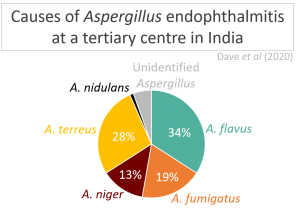Submitted by Aspergillus Administrator on 9 May 2012
A recent TV programme on the BBC ‘After Life – the strange science of decay‘ covered the highly important role that fungi play in removing much of the dead plant & animal material that is generated every day in our world and converting it into new food for new organisms.
This was not really something new to many of us though it was fascinating to follow the sequence of organisms as dead meat & plants were efficiently reduced to nothing in a matter of 50 days. However there was something new (to me) that came up during the programme – the role of fungi in defining what life currently lives on earth.
The Cretaceous period was a time of great plant growth and the world was covered in woody plants. This had an unfortunate side-effect in that large amounts of carbon dioxide became trapped in the woody stems of these plants with no way for it to be released again – the earth was running out of CO2!
Evidence shows that in some parts of the world a large cataclysmical extinction event (thought to be an asteroid hitting the earth) marked the end of this geological period. A research team in New Zealand found an 8cm seam of coal marking this event in which there are a proliferation of forest-type plants as you might expect if the forest was flattened by an explosion or died following loss of light due to dust thrown up by the explosion blocking out sunlight.
At the top of that seam of coal is a remarkable feature – a layer almost completely consisting of fungal spores and other fungal material. The implication is that fungi proliferated at this time and may well have destroyed what was left of the tree life after the extinction event.
 |
| Dinosaur eggs contaminated by fungi |
The authors speculate that there would have been a world dominated by fungi for a few years. This period would have been a time of intense fungal growth and adaption, probably even including the development of the ability to break down and digest wood. Once able to use wood as a food source fungi would have been able to feed on much of the fallen plantlife, releasing vast quantities of carbon dioxide – with much the same effect as we are experiencing now i.e. Global warming.
The chances are that the period of intense fungal growth would have denied large predators food and along with the reduction in plant life could account for the disappearance of the large dinosaurs – and also account for the lack of fossil fuels laid down after this time as plant matter would have been eaten by fungi rather than left to become buried over time.
It is also speculated that this was the time that fungal plant pathogens would have arisen, driving the evolution of many of our modern plants.
Remember also that mammals maintain a high body temperature inhospitable to fungal growth – to this day relatively few fungi can infect mammals. It is likely that those early mammals were highly resistant to fungal attack, unlike their cold blooded reptile neighbours. A very recent paper has detected fungal contamination of dinosaur eggs. Perhaps this is one more reason why dinosaurs died out and much smaller mammals inherited the earth – some even suggest it is the main reason.
News archives
-
Title
Date



